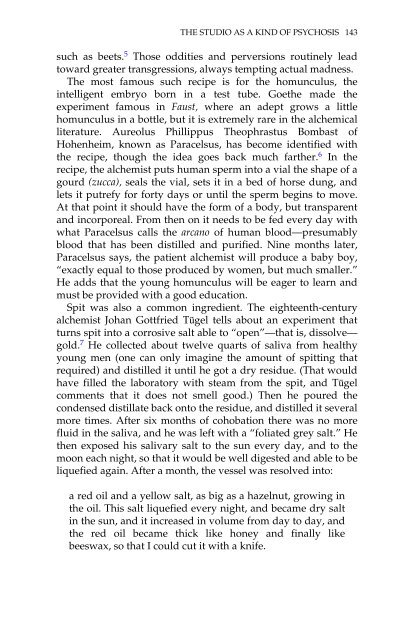What Painting Is: How to Think about Oil Painting ... - Victoria Vesna
What Painting Is: How to Think about Oil Painting ... - Victoria Vesna
What Painting Is: How to Think about Oil Painting ... - Victoria Vesna
Create successful ePaper yourself
Turn your PDF publications into a flip-book with our unique Google optimized e-Paper software.
THE STUDIO AS A KIND OF PSYCHOSIS 143<br />
such as beets. 5 Those oddities and perversions routinely lead<br />
<strong>to</strong>ward greater transgressions, always tempting actual madness.<br />
The most famous such recipe is for the homunculus, the<br />
intelligent embryo born in a test tube. Goethe made the<br />
experiment famous in Faust, where an adept grows a little<br />
homunculus in a bottle, but it is extremely rare in the alchemical<br />
literature. Aureolus Phillippus Theophrastus Bombast of<br />
Hohenheim, known as Paracelsus, has become identified with<br />
the recipe, though the idea goes back much farther. 6 In the<br />
recipe, the alchemist puts human sperm in<strong>to</strong> a vial the shape of a<br />
gourd (zucca), seals the vial, sets it in a bed of horse dung, and<br />
lets it putrefy for forty days or until the sperm begins <strong>to</strong> move.<br />
At that point it should have the form of a body, but transparent<br />
and incorporeal. From then on it needs <strong>to</strong> be fed every day with<br />
what Paracelsus calls the arcano of human blood—presumably<br />
blood that has been distilled and purified. Nine months later,<br />
Paracelsus says, the patient alchemist will produce a baby boy,<br />
“exactly equal <strong>to</strong> those produced by women, but much smaller.”<br />
He adds that the young homunculus will be eager <strong>to</strong> learn and<br />
must be provided with a good education.<br />
Spit was also a common ingredient. The eighteenth-century<br />
alchemist Johan Gottfried Tügel tells <strong>about</strong> an experiment that<br />
turns spit in<strong>to</strong> a corrosive salt able <strong>to</strong> “open”—that is, dissolve—<br />
gold. 7 He collected <strong>about</strong> twelve quarts of saliva from healthy<br />
young men (one can only imagine the amount of spitting that<br />
required) and distilled it until he got a dry residue. (That would<br />
have filled the labora<strong>to</strong>ry with steam from the spit, and Tügel<br />
comments that it does not smell good.) Then he poured the<br />
condensed distillate back on<strong>to</strong> the residue, and distilled it several<br />
more times. After six months of cohobation there was no more<br />
fluid in the saliva, and he was left with a “foliated grey salt.” He<br />
then exposed his salivary salt <strong>to</strong> the sun every day, and <strong>to</strong> the<br />
moon each night, so that it would be well digested and able <strong>to</strong> be<br />
liquefied again. After a month, the vessel was resolved in<strong>to</strong>:<br />
a red oil and a yellow salt, as big as a hazelnut, growing in<br />
the oil. This salt liquefied every night, and became dry salt<br />
in the sun, and it increased in volume from day <strong>to</strong> day, and<br />
the red oil became thick like honey and finally like<br />
beeswax, so that I could cut it with a knife.


